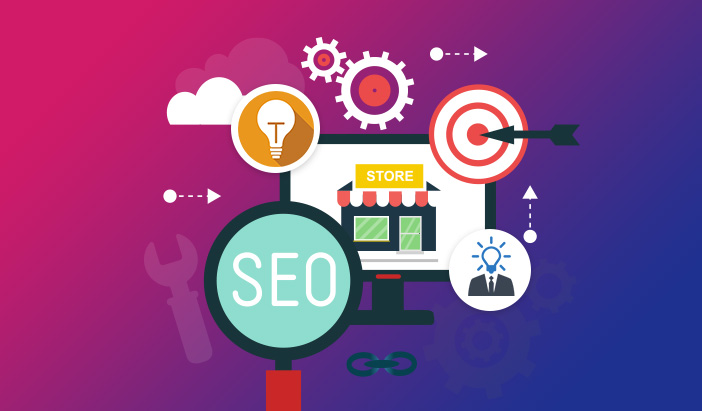27 SEO Professionals Share Their Ecommerce SEO Tips for 2018
- Syed Muneeb Ul Hasan
- October 3, 2018

Search Engine Optimization is one of the most fundamental aspects involved in bringing yourself into contention in the world of e-commerce. For all the times SEO has been neglected in the pursuit of scaling businesses, has returned to make a statement that it is here to stay, because of the benefits it provides.
To have a better understanding of how SEO helps scale businesses, we spoke to the most evident influencers for the best Ecommerce SEO tips guaranteed to help make brands and products more visible to the audience.
Read: How to Improve Magento 2 SEO
Here’s what they had to say;
Jeff Lenney

Bio: Affiliate Marketer and Search Engine Optimization Expert. Also a Blogger at JeffLenney.
![]()
Focus on ranking category pages OR blog posts instead of just individual product pages.
Google loves quality CONTENT these days, and you’re going to be able to get a lot more content in a blog post or category page.
I’ll briefly cover both below:
For example, one of my clients ran an outdoor camping & survival E-Commerce store since the objective was to increase their organic traffic.
They knew a little bit about SEO, but mostly enough to get them in trouble.
They were putting time into optimizing single product pages such asCamping Shovel, and Outdoor Ropes with very little content.
To improve their on-page SEO, we started creating blog posts centered around camping and ranking them for various long tail but relevantkeywords.
For Example:
– Camping Cooking Equipment
– Camping Supplies List
– Family Camping Checklist
– Etc.It’s then easy to build internal links from these blog posts to the various products the store was selling, and various categories as well. Thisnot only helps keep your bounce rate low, but also helps pass authorityaround the website while helping it rank better overall.
We used Google search and the Google keyword planner to get ideas of whatpeople were searching for. We also used Ubersuggestto come up with additional ideas.
Next up, we put more focus into optimizing product categories, for example, http://domain .com/outdoor-gear
We increased the content on each category page to 1500 words minimum, made sure the images were named according to the product.
After the content was optimized, we focused on the basics on on-page SEO, including but not limited to:
– Optimizing the Meta Title and Description
– Optimizing the URL Itself (/outdoor-gear/ vs ‘/gear/, for example)
– Write UNIQUE descriptions for each of the products (very important).
– Use Header Tags (h2, h3, h4) to break up content, and better
categorize it
– Add Schema Markup (plenty of wordpress or magento plugins for this)
– Ensure the content is UNIQUE for similar products, and not just copied
from one to the otherAt any rate, there is obviously a lot more to SEO than what I coveredabove, but by simply doing the above, you’ll generally have a leg up on your competitors who aren’t doing any SEO at all.
I see e-commerce stores everyday that aren’t doing SEO right, or could improve on one or more of the above things I listed.
Carlos Rosado

Bio: SEO Manager at Thrive Internet Marketing Agency.
![]()
Content
One of the most common SEO practices for many SEO specialists is content. Having a detailed products page is important when you are trying to provide size, style, colors, and dimensions on a product you have on your site. The more detail you have on the product, the better it is for the consumer when it comes to making a decision. There are so many eCommerce accounts who do
not provide content and feel a photo is more than enough, but that is not the case.Related Products
Having related products or other’s recently purchased provides another way to help the user understand that there are products that can go very well with the item they are currently looking at.
Reviews
Having reviews on the product page shows users who have purchased the product but also provide a level of confidence with the consumer when they see what other people thought about your product. Word of mouth becomes a big player with reviews and can see a conversion increase from it.
Sam Olmsted

Bio: Director of Search and Content at Online Optimism
![]()
Most businesses think that advertising is the best way to drive product sales online. However SEO has its own importance in ecommerce.
Here are top 3 ecommerce SEO tips for 2018:
1. Unique, Specific, and Lengthy Product Descriptions: A lengthy copy is your friend when it comes to ecommerce SEO. You want to fully explain your product’s features and embed keywords into your description. “Blue Hat for Summer Vacation” sounds better than “Hat.” By expanding your description, Google and consumers will find your product easier.
2. Add Schema Markup: Schema is the language of the Internet. While you want to speak to readers, you also want to speak to Google. Schema markup encodes specific descriptions into your product details.
3. Create More Pages: Create individual pages with unique URLs for each product. This will make each product more searchable on the web and identify them as individual items and not part of a larger set.
Adam White

Bio: Founder at SEOJet
![]()
Now that Google has changed their algorithm again, the most important thing an ecommerce business can do is create brand trust with Google. This means building links to their homepage using branded anchors in the links. The more Google trusts your ecommerce store as a brand, the higher they will rank your product pages, even when you haven’t built any links to those pages. The thing you must NOT do is try to target key phrases on your homepage. That will ruin your brand trust really quickly.
Jim Milan

Bio: Communications and SEO Manager at Auto Accessories Garage.
![]()
Here are some Ecommerce SEO Tips:
Sometimes ecommerce stores with large product catalogs carry an assortment of similar SKUs with pages that are competing with one another for the same keywords in search engines. This keyword cannibalization can hinder the overall search engine traffic to the site. Reducing this index bloat can often lead to a quick increase in organic traffic for a relatively low investment of time and energy.
Crawling your site with Screaming Frog will provide a list of all the URLs on the site. You can then pull the traffic data for your landing pages from the past year or two from Google Analytics and match it up with the URLs you pulled from Screaming Frog. The next step is to analyze the traffic
data and determine which pages are worth cutting from the index. You can most likely eliminate any pages that have received little to no organic traffic hits by adding a noindex tag to these pages. After adding the noindex tags to these extraneous pages, analyze how your organic traffic responds. You should see a noticeable boost in organic traffic in the subsequent weeks.
Val Zamulin

Bio: Founder of SeoLogist
1) Incentivized UGC
UGC stands for User Generated Content. Google loves UGC because their entire business concept is built upon it. Establishing the system that rewards users for providing authentic product-related content to you is a self-serve, super-innovative and wildly successful tactic that we found to be extremely helpful to our ecommerce clients. Various UGC such as real product reviews in a rich media format, comments, discussions, social trail and other feedback is a dynamite! Best yet, the leading UGC platforms like Origipost or Influtive are working on the plug and play Magento extensions that will satisfy the growing needs of the market for this super innovative technique!
2) Mobile-first Indexing Optimization
The Speed Update and Mobile-First Indexing are the biggest SEO buzzwords of 2018:
– Responsive design is a must!
– Compress your rich-data.
– Minimize client-side scripts. Minimize your source code. Leverage browser caching.
– Strive for perfection
– Keep in mind that starting July 2018, Google only really rewards ecommerce sites that load in 2 seconds or less. However, based on what we’ve seen so far, if you get your load speed to that level you’ll immediately receive an SEO traffic spike.
Matthew Post

Bio: Matthew Post is an SEO Expert
![]()
One of the best Ecommerce SEO Tips is to make sure that you have a detailed and unique products description. Product descriptions are often overlooked with eCommerce stores and it is the best fix that will give site owners an almost immediate boost. Be sure your descriptions are unique and not
just a copy of the manufacturers’ details.Additionally, with the latest Google update, it is imperative now, more than ever, that online stores have a thorough About Us and Contact Us page. Both of these will help establish trustworthiness in the eyes of Google and potential customers.
Scott Fish

Bio: Founder and CEO at 32 Degrees Digital
![]()
Strategy 1.
Think about your e-commerce website in two ways, one it is a directory of products for which people are searching for, and two, it is a platform for you to inspire somebody to make a purchase. Often, an e-commerce platform can be simple and rigid, so it is a good directory, but it’s missing out on conversion points. More importantly, it’s missing the inspiring side. As a 15-year veteran in search engine optimization, a lot of the technical and on page strategies that we implement drives a lot of traffic, but if the conversion piece isn’t there, then that traffic is wasted. Take time to consider how to make your Ecommerce experience inspiring and interesting for visitors.
Strategy 2.
Most e-commerce platforms that someone might be working with, whether it’s WordPress or Squarespace, have SEO functionality built into them. You will be able to implement title tags, and tag your images. But by simply adding in SEO elements, you won’t necessarily gain traffic from the implementation. The missing piece is strategy. Sitting down with your team and figuring out how people are searching for the products that you sell is extremely important. Often, people search for products and what they do or what they can solve, rather than what they actually are. That is an important set of keywords to address when you look at creating a keyword optimization strategy for your eCommerce site.
Strategy 3.
Marrying up your SEO strategy with your paid search strategy, means that you will save money over time and have a more informed eCommerce SEO strategy for your business. When you use Google AdWords or other Ad platforms, you are able to Target keywords and understand the search volume that comes for those keywords, but more importantly you are able to test different landing pages and user experiences to see what combination converts the best. Taking the data from Google AdWords and applying it to your SEO campaign, you now know the keywords that you should be targeting that drive the most qualified traffic, and the user experience that will drive the best conversion rates on your website. When we work with clients, one thing that we like to do, even if we are only working on an SEO campaign, is to put together a small ad campaign to test out these strategies.
Steve Page

Bio: VP of Digital Strategy at GiantPartners
Here is a list of Ecommerce SEO tips that you can use. A lot of it has to do with User Experience:
Don’t post content without images or video
User experience is a big factor for your website visitors. Keeping them on your site as long as possible will help your website perform better in Google’s search results. Video also plays a big factor in keeping people on your site engaged for a longer period of time.
Bonus tip: Having a Youtube video on your page looks good in Google’s eyes because they make money on Youtube Ads. So they will show pages higher with Youtube videos on it so more people will watch the video with the ads putting more money in Google’s pockets.
Include structured data and rich snippetsClick through rate on the Search Engine Ranking Pages (SERPs) can affect where you show up on the page. If your result has a high click through rate, Google will move you up its rankings. The most important Schema markup for Ecommerce is the star reviews that show in the result. You can use schema markup and rich snippets to get this to show in your results so that your site stands out from the rest, therefore getting you more clicks.
Build High Quality backlinks using HAROThere are always journalists from big publications like Buzzfeed, Forbes, Hellogiggles looking for products for their gift guide. A link from one of these sites can have a big impact on your sites rankings.
Cory Young
![]() Bio: Works at BCC Interactive Digital Marketing
Bio: Works at BCC Interactive Digital Marketing
Write engaging quality content for your category pages
Your category pages are likely the strongest pages outside of the homepage from an
authority standpoint, the key is to make them work for you with accurate, relevant information. Sites in the top positions usually have around 900 words since Google rewards long form content, so aim for around that number.Focus on Topics and Not Keywords
As Google’s algorithm has become more sophisticated, it has put an emphasis on topics more than keywords. Now keywords like, buy a plane ticket, buy a cheap plane ticket, and best time to buy a ticket may sit on a single page called The Ultimate Guide to Buying a Plane Ticket. Focusing your content on topics that fulfill user intent and behavior will help you dominate the e-commerce SEO landscape.
Kim Smith

Bio: Content Marketing Manager at GoodFirms
There are always some product pages that are out of stock for a long time. Or maybe you no longer even selling that product. You don’t want web crawlers to crawl these insignificant pages. Deleting these pages would cause errors, so instead, put them into no-index tag or redirect the URL to a similar product page.
– Use Canonical tags to manage your duplicate content. There might be products with different colors or patterns, resulting into distinct pages with similar content. Use Canonical rel tags where needed to let Google know that these products are different.
– Google’s algorithm now ranks websites by considering their mobile versions first. Hence, optimizing your eCommerce store making it mobile-responsive is important.
– Your eCommerce website would have too many URLs, and you need to prioritize which one you want indexed first. So, be wise while choosing the pages to add to your sitemap as adding unwanted pages won’t give you the results you desire.
Derek Robinson
![]() Bio: Founder/CEO at Top Notch Dezigns
Bio: Founder/CEO at Top Notch Dezigns
![]()
Researching and using efficient keywords is the ideal place to start. Make sure you use them in anchor texts. Do away with any kind of duplicate content and broken links. Keep the product descriptions compelling and to the point. Optimize images using ALT tags and descriptions. Ensure that your URLs are optimized for search engine crawling. With all these in place, determine if the traffic coming your way is actually converting into sales.
Andrew Allen
![]() Bio: Co-founder at Hike SEO
Bio: Co-founder at Hike SEO

– If you sell products that have universal ID’s/SKU codes, then they can benefit from having that code wrapped in a heading (usually). This will make your site appear better for those searchers who know exactly what they’re looking for and search via these codes in Google (more than you think!)
– Do a site:domain .com search on Google to spot any unwanted pages that Google has indexed and is likely crawling frequently. If any of these pages are not going to provide any SEO value (eg they are duplicated pages, account pages, query pages) then stop them from being indexed and crawled via noindex tags and by updating your robots.txt file
Adeel Akhter

Bio: Head of Operations at WP Hood
![]()
Here are some of the Ecommerce Seo Tips:
1. Make sure all your category pages are linked from the home page.
2. Always have separate home page for every product category. For example, if you sell gadgets and sports products, create separate home pages for both the categories.
3. Add about us, contact us pages in the footer.
4. One product may be have multiple color variations with different pages. For example a red sports shoe page, a black sports shoe page and so on. Google can count this as duplicate content. Use canonical tags.
5. Add unique product descriptions.
6. Do writer meta titles and unique meta descriptions. Many e-commerce stores avoid this step because of too many pages.
7. Prioritize your e-commerce important pages on the sitemap. E-commerce websites have plenty of pages and if you add them all to the sitemap, crawlers will end up crawling plenty of low priority pages.
8. Avoid using heavy images. And make sure for every product you optimize, do it with Alt text.
9. Add a blog to your site and create high quality review based blog posts for products you sell. For example, if you are selling 10 laptops of brand A, create a detailed blog post on the top 10 brand A laptops. Link every laptop to the product page.
Jason Scott
![]() Bio: Digital Marketing Specialist at Archway Cards Ltd
Bio: Digital Marketing Specialist at Archway Cards Ltd
![]()
Often the best Ecommerce SEO Tips out there are tried and true. Trendy tricks and strategies to boost rankings come and go, but the fundamentals always remain. Subsequently, my number one SEO tip for someone running an eCommerce store in 2018 is to ensure your website is architecturally sound. Many people are worried about what form of content they should be creating or what backlinks they should be seeking when the foundations of their site are not in place.
This includes ensuring your site looks good across all devices, ensuring it loads quickly and also ensuring that all your meta tags are present, unique and optimised for the targeted keywords. Do the basics right and you’re setting yourself up for long-term SEO success.
Sam Carr
![]() Bio: Marketing Manager at PPC Protect
Bio: Marketing Manager at PPC Protect
![]()
I have a few Ecommerce SEO tips and tricks up my sleeve.
The first one is to always make sure your product images have the correct alt text. A lot of stores will upload lots of pictures but won’t spend the time making sure they are optimised correctly. By adding the correct alt text to images you can: improve the relevance of the page, make the images rank in Google, and give good technical signals to crawlers.
The next tip is to always make sure you have keyword rich URLs. Many platforms love to spit out random URLs related to products that have no SEO value. By changing these to URLs that contain the product name, brand and keyword, it will make it much easier for crawlers to understand what the page is about.
My last tip is to always make sure your category pages are well optimised. When a user searches for an item e.g. hoover the individual product page will most likely rank higher. But when a user searches for items e.g. hoovers then usually the category page will rank higher up. This is to do with user intent and if the user is shopping for hoovers, then they’ll probably want to check out more than one. To make sure you get the most out of your category pages, you should optimize them for these plural keywords that people are likely to be searching for. This means proper headings, content and as many relevant products as you can fit on the page.
Iga Wójtowicz

Bio: Project Manager at INVO Technologies
![]()
Here’s what I find necessary for ecommerce to take into account in 2018 when it comes to SEO:
First of all, never forget to stay updated when it comes to the Google algorithm. Right now, because of the latest changes Google is implementing, building a backlinks profile for your domain may not be enough to score high on SERP. Having mentions about your website or products will always be valuable (in terms of PR and marketing, for example) but it may not be as valuable for SEO as it is now, once the changes in the algorithm are implemented.
The changes I described above are all leading to implementing the AuthorRank. This is something that instead of judging the website’s rank, judges the level of expertise the author of certain content has. This may mean that anonymous content will no longer score high in Google.
All this might actually turn out positive for ecommerce! If you can present your audience and clients with professional knowledge then Google will reward you with a high position on SERP.
So my best Ecommerce SEO tip in 2018 would be to always share valuable, expert knowledge with your customers!
Boris Goncearenco

Bio: Marketing Manager at New York Furniture Outlets, Inc
![]()
I can say that in general, nothing serious has changed. Maybe Google’s algorithm became more strict in terms of tricky SEO techniques, but still, unless you’ve been under a rock all this time, I am sure, that you didn’t experience any serious changes. Anyway, here are my Ecommerce SEO Tips in 2018:
1. Add additional and related products on your product page. This will enhance the internal linking, and increase conversion rates, time spend on site, etc.
2. Create query-tailored landing pages for your top products. Your top 10 sellers, especially if these generate a big part of your total revenue, deserve special attention. Create special landing pages for such products, fill it with interesting, useful long-read content (1000-2000 words). Also each landing page should fit multiple keywords, making your SEO procedures more efficient.
3. Use different approaches to keyword research, for example Amazon search suggestions.
4. Structured data. Good ol’ structured data. Must-haves are product and breadcrumbs structured data. These are the most important in terms of having good appearance in the SERP.
5. Do the basics as well: titles, image alts, headings. These should contain your primary and secondary keywords for this page. For example if your h1 has primary keywords, h2 should contain secondary ones.
6. Site speed and performance. Since performance of the website is one of top 10 ranking factors, it is advisable to make your website load faster and appear correctly on all devices.These are the features of SEO of 2018, but I think there is much more to come. A universal answer, that 2018 year is the year of content marketing, but to be honest, none of these techniques will work independently. Only joint efforts in all dimensions at once will give you the desired result.
Marina Dolcic

Bio: Works as an analyst at Morningscore
![]()
Here is my take on 5 Ecommerce SEO tips that are easy to do (or keep in mind):
1. The most important thing to remember is that SEO is not optimization for Google. Google crawlers aim to find the most relevant and user-friendly content. So, if you optimize for maximum user friendliness with relevant content to follow, then Google will love you (and reward you) too.
2. Use the extra SEO opportunity and optimize your URLs. Short, keyword rich URLs rank higher on Google’s SERPs. Forget URLs like www.myshop .com/products/productid=4bd7329272 and use the product name instead. Www.myshop .com/products/baseball-cap-black is easier for the user to memorise and type in, it is descriptive, keyword relevant and helps you rank better with Google.
3. According to Forbes, websites with less than 300 words per page are considered “thin” by Google’s standard and don’t rank as highly in the SERPs. It is therefore important to include rich descriptions of your products in your product pages. Short and sweet just won’t do. Not only will this method let you use your keywords more, but longer descriptions will be something your customers will appreciate, and it is also bound to increase conversion rates.
4. Use breadcrumbs. They look something like Home>Clothing>Women’s>Dresses and show the customer where exactly they are located on your page (and helps them navigate faster). Google loves them because it improves internal linking, makes it easier to establish site architecture and spread link juice. Most platforms have it integrated and there are also plugins available to help set them up.
5. If your website has duplicate content it will struggle in attaining better results in the SERP rank. This can easily happen to large ecommerce sites that have products with various sizes and color options. You can easily check the extent of the problem with a tool called Screaming Frog. It crawls your entire site to give you a detailed list of duplicate URLs, page titles, meta descriptions, tags and more. The free version of Screaming frog is limited to 500 URLs, so you will have to pay for this tool if you have a bigger site. But it is priceless, when you take into consideration that Google sets high value on high-quality, unique content in ranking.
Chris Mindel
![]() Bio: Marketing Manager at Dexter Edward LLC.
Bio: Marketing Manager at Dexter Edward LLC.
![]()
SEO for ecommerce is a process, but fun to do if you love your products and customers. Of course, you have to make sure you site is set up right. It should have the proper (but not stuffed) keywords and meta description. Your site should be easy to navigate in all aspects of the customer’s journey (finding products, learning about your company, actually helpful FAQs, etc.). Let’s assume you have basic SEO in place for your site. Now onto the important things: your products.
Never skimp on the care and importance of each and every product page. Imagine each product from the customer’s point of view. Think about the most common words they’d use to find the product. Use those words in as many places as possible on the page, but naturally – don’t just cram them in. Use the name of the product on the page a few times – again, naturally. Craft both into a product description that informs and entertains the customer, including as many details about the product as possible (dimensions, fabric content, taste, benefits, etc.).
Make sure your photos show the product accurately and highlight important or unique features., and don’t forget alt text for each one (using the product name and/or your key search terms). If you are able to, add some video – actually show what the product can do. Just be mindful of the length. After 10 seconds, people stop watching (in a drop off curve that’s almost exponential), so pack those first few seconds with things to make people want to continue watching.
All this attention with the product name and key search terms will show search engines the importance of these terms for this page. Also, the attention in the descriptions, stats, and photos will allow other sites (blogs, news, reviews, etc.) to easily link back to your site. Backlinks show search engines that your site is important – the more, the SEO-er. Even having a video channel repository for your video content can help with this extra linkage.
And finally, don’t post all your new items at once. Spread them out and have a page to feature new items. The more days you can have new content on your site, the more important you will seem to search engines.
This plan might sound simplistic, but it comes with over a decade worth of success behind it. Following these ecommerce SEO tips, your online store should greatly improve, with your product listings often ranking higher through organic search than the manufacturer pages for the same items.
Rod Holmes

Bio: Partner & Director of Sales at Chicago Style SEO
![]()
Here’s my Ecommerce SEO Tips:
Expand content on category pages
Most of the searches done are for category-level keywords. Google rewards longer content (many studies back this up), but category pages are generally only a list of products in the category. By adding authoritative content to category pages, our clients see more organic traffic to those pages and more purchases.Structured Data Markup/Micro Data
This isn’t all that new, but the number of ecomm sites that don’t use structured data markup is staggering. It’s easily the lowest hanging fruit for way too many sites that don’t have it.
Eliminate competing pages
Many ecomm sites unknowingly have competing pages for the same keyword. This is often a technical issue due to two different URLs pointing at the exact same page—often due to tags or categories. Sometimes, however, the website has grown out of control and there are multiple pages for the same thing. These need to be filtered out and either combined/eliminated.
Custom Photos & Descriptions
Way too many ecomm sites use the manufacturers’ descriptions of the products and their photos. Google rewards unique content, not copy/paste from the manufacturer. All ecomm sites should write long, unique product descriptions for important products (including paragraphs about why they love the product and sell it). Same with photos…take your own. We had a bike shop client who took a picture of every bike model they sold leaning against a brick wall behind the shop.Google LOVED it! They basically had the only non-manufacturer photo of the bike available on the web and Google amped up their authority considerably because of it. Sure, they got tons of traffic from people who didn’t live anywhere near by and wouldn’t buy from them, but Google saw it as a sign of authority on the topic and they ranked higher locally because of it.
Model Number!!
It’s scary how many ecomm sites we find that don’t have the manufacturers’ model number for products. If someone knows exactly what they’re looking for, they’ll search for the model number. Makes sure it’s on your page and marked up correctly.
Swapnil Bhagwat

Bio: Senior Manager at Orchestrate TechSolutions
![]()
For an Ecommerce Portal, optimizing its content for Search engines is essential. While there are several Ecommerce SEO tips that can be helpful, the most important of them to create and use the content that buzzes with your target audience. It is vital for all online businesses to create content that is original and supports it through meticulous practices such as meta-tagging.
It means, the portal should refrain from using the images and product descriptions found on their competitors’ websites. Also, irrespective of the effort you put in other online activities, you need the right content to back it up to improve your SEO.
Sean Dudayev

Bio: Business Growth Expert at Frootful Marketing
![]()
One of the most ignored SEO tactics in the e-commerce space is content creation. Most ecommerce platforms focus on more SKU’s and more pages, maybe more links. What almost no ecommerce company implements is a targeted content campaign. The only thing Google loves more than an optimized page is optimized educational content. Most e-comm sites don’t do this because they don’t think it will gain revenue but it will if you go about it right. For example, if you sell lights on your platform, create content about decorating your home gym or 5 ways to make your office more productive. There are people looking for this advice out there and you can be a useful source to them. What that will then do is bring traffic to your site, expose them to your brand, and at the same time, give you a chance to include your product as one of the solutions. This can have a HUGE impact on your sales. I’ve successfully done this and increased the sales of an E-commerce site by 30%, one that was capped out on their paid earnings.
Sean Flannigan

Bio: Project Manager at INVO Technologies
![]()
As always, it remains important to optimize product and category page elements like title tags and H1 tags with well-researched keywords for each. Further, avoiding keyword cannibalization is very important for keeping your most valuable products rankings individually for high volume keywords and not battling each other. That said, there has to be a good content strategy to accompany any eCommerce store. Product and category pages do not rank as well as content-focused pages.
Creating information-rich blog posts based on good keyword clusters research can help a brand rank for higher volume keywords, driving traffic onto the site. Including good internal links to encourage interaction with the site will engage users with your products and brand.
Sajjad Shahid

Bio: Ecommerce Community Manager at Cloudways a Managed Ecommerce Web Hosting Platform
![]()
My number one tip is to improve your money pages. Let’s say your website has a few top selling products. Take their product descriptions to at least 800 words. Add three relevant keywords where you want the product to rank, play with LSI keywords and synonyms.Now build links to these pages from sites that have DA 40+. Link them internally from category and even home page if they are your features products.Secondly, get screaming frog and closely monitor the on-page structure of these pages.Google now prefers structured data to understand the nature of a page. So, it is better to add comparison with other relevant products in the form of a table. This way it will rank your product description even on price comparison queries.Once all this is done. Write a 1500+ word blog reviewing the product and link back to it. Repurpose this blog into a video, slide, infographic, and share on all submission websites. Do this with all essential products on your website. You will soon see the results.
Nate Masterson
![]()
Bio: Marketing Manager at Maple Holistics
![]()
Optimize Page Speed
When it comes to an E-commerce website, it’s important to rank highly for the relevant keywords associated with your products. Otherwise, customers simply won’t discover your product pages through search engines. By making sure your page speed is up to par, you can outrank competitors and rise to the top of the charts. Host your website on servers with enough power to handle your traffic and implement AMP pages for an extra bump from Google.
Structured Data
Boosting your site’s SEO is no easy task, especially considering that your ranking is determined by a constantly evolving complex algorithm. There are a number of factors which can influence your SEO and overall domain authority, but some are more proven than others. While there are a few tricks which go unnoticed by real web users, some SEO practices directly attract search engines and real people. In my experience, few SEO tricks are as effective as integrating structured data coding into your web-pages. This straightforward technique essentially helps search engines better understand your content and codify it, providing searchers with rich results and a more attractive interface. Between featured snippets, reviews, and video results, there’s no denying how valuable structured data can be.
MIKELamood Corporation
Your product page title tag should combine keywords that accurately describe the product as well as what your customer is searching for. Also ecommerce meta descriptions should include the product’s name and your targeted keyword. Google bolds the keyword in the meta description that your customer searches for and will make your site stand out in SERP.
Cassidy Barney
![]()
Bio: SEO Manager at Epic Marketing
![]()
Your product page is the most important page because if it’s built correctly, your traffic and conversions will see a dramatic increase. Be sure to keep each product page consistent with your brand, while devising ways for boosting
your customers’ loyalty.Top Ecommerce SEO Tips to Optimize Your Product Page:
1. Have a featured image
2. Have multiple product photos from different angles
3. Optimize product overview, description title, price, features & benefits
4. Include unique CTA
5. Include reviews and ratings


